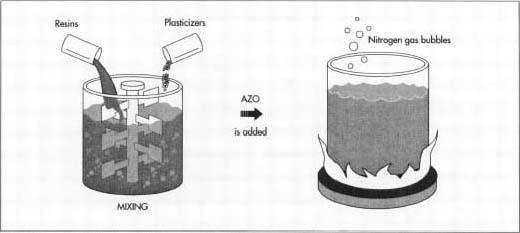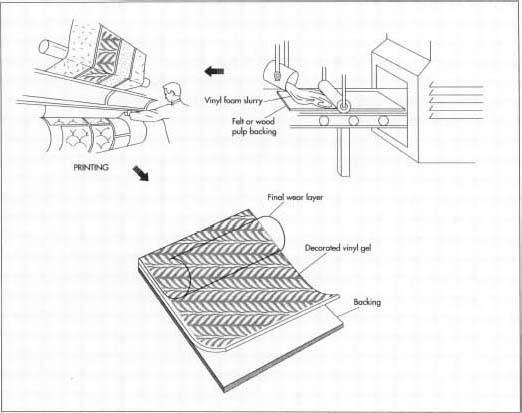Vinyl Floorcovering
Background
Vinyl floorcovering is defined as either resilient vinyl sheet floorcovering or resilient vinyl tile floorcovering. Vinyl sheet floor-covering is generally available in either 6 ft (1.83 m) or 12 ft (3.66 m) widths and vinyl tiles are generally 12 x 12 in (30.48 x 30.48 cm). Sheet goods are generally retailed with no sticky backing. Thus, adhesives need to be purchased to adhere the flooring to underlayment. Vinyl tiles may be purchased dry or with a pressure-sensitive glue backing protected by a paper covering that must be removed by the installer.
Vinyl sheet flooring, particularly, varies in thickness and in manner decorated. Thinner sheet vinyl is 10-15 mils (mils are a thousandths of an inch) in thickness as opposed to longer wearing sheet vinyl (which is also more expensive) that may be 25-30 mils thick. Patterns may be printed with a rotary press (called rotogravure printing) or with large plates engraved intaglio with the design engraved below the surface of the metal. Both printing methods impress a pattern on top of the gel layer of foam and underneath the wear layer, rendering a relatively durable pattern.
These vinyl floorcoverings are preferred by many homeowners for their ease of installation—many do-it-yourselfers are able to install them with relative ease. However, vinyl sheet floorcoverings that are 25-30 mils may difficult to handle or install for the unskilled homeowner. The vinyl tiles are far easier to install and are the vinyl flooring most often installed by the home-owner. Furthermore unlike other flooring materials, sharp blades will easily cut the vinyl flooring so that it may conform to corners, cabinets, and curves.
In addition, vinyl floorcoverings may be applied over old flooring, and are easily cleaned with a vacuum or a mop with soap and warm water. To the delight of many householders, with proper care, many brands do not require waxing. Polyurethane coatings render a high-gloss finish that emulates a shiny, waxy surface and generally stays rather shiny over the years. If dulled, a special vinyl floor finish may be applied. However, vinyl floorcoverings are not as durable as ceramic tile and will have to be replaced periodically.
As with many household materials, vinyl sheet and tile flooring comes in residential grade and commercial grade. Residential vinyl flooring varies in thickness, method used for imprinting or decorating, and style. Commercial vinyl floorcoverings conform to specifications that require superior durability and stain resistance (particularly use-ful in hospital settings). Some commercial-grade vinyl floorcovering is non-slip for high public traffic areas.
History
Housewives have long known that a hard, relatively waterproof surface makes a fine floorcovering. Tamped earth mixed with ox blood dried into an easily-swept surface in primitive homes. Painted wooden floors were relatively easily maintained but had to be renewed at some effort. It was particularly troublesome keeping carpeting clean in eating areas such as dining rooms. In the early eighteenth century, floor cloths, which were large squares of fabric, were laid under dining tables to catch wayward crumbs. These floor cloths were simply taken outside and shaken free of crumbs and returned to their spot under the table.
However, later in the 1700s, someone decided that the floor cloth could be improved upon if a relatively sturdy fabric such as canvas, hemp, or linen was coated with and evaporating oil and paint and thus made waterproof. Easy to scrub and sweep, these floor oilcloths were quite an improvement over the fabric floor cloths. Better yet, these oilcloths were inexpensive and could be hand made at home or purchased mass produced later in the nineteenth century. From there it was a quick hop to linoleum which was manufactured from linseed oil, cork gums, and pigment. This leather-like floor-covering was mass produced by 1890 both in the United States and abroad.
Linoleum was tremendously popular from 1900 until after the World War II when floorcovering manufacturers sought to replace linoleum with other long-wearing fashionable, easily maintained floorcoverings. By the late 1950s, resilient floorcoverings were here at last—these included vinyl flooring which gives slightly as one walks across it. These vinyl floorcoverings were far brighter and more colorful than linoleum because the vinyl floorcoverings were made with a clear vinyl gel which made the printed colors vibrant. As a 1960 Sears Catalog proclaimed about vinyl floorcoverings: "All gloss and glow—no hard work!"
Raw Materials
The primary components of vinyl floorcoverings include polyvinyl chloride (or vinyl) resins, plasticizers (high molecular-weight solvents), pigments and trace stabilizers, and a carrier sheet or backing. The backing may be felt or highly filled paper made from wood pulp and calcium carbonate. High-gloss surface vinyl sheets or vinyl tiles have an additional polyurethane coating applied at the end of the process. The glue applied to the back of some vinyl tiles (to make a pressure-sensitive adhesive) is made from organic resins.
Design
The design departments of vinyl floorcovering companies are constantly seeking new inspiration for successful patterns and colors that will work in sheet and tile form. The designers work with marketing groups to determine what colors and styles will capture the public's interest as much as five years from current production. The designs are transferred from drawing to computer, and mock-ups of the different patterns are produced in an array of colors. The designs are then printed off of the computer on full-size paper and in full color.
If a full-scale paper pattern is approved for further development, printing plates either 18 x 24 in (45.72 x 61 cm) or 24 x 36 in (61 x 91.44 cm) in size are created by engravers. These plates are then used to print samples of the pattern on undecorated flooring (called gel stock) as prototypes. The wear layer, or final, often shiny surface of the sheet flooring, is applied over the printed pattern, so the designers have a close approximation of the finished product.
The prototype is either approved as is, retooled, or dropped. The time it takes from design to market varies from as little as three months or as long as six months.
The Manufacturing
Process
Making the vinyl sheet
floorcovering
- 1 Vinyl resins and plasticizers are stirred together in a vat to make a plastisol. To this plastisol, AZO compound (which consists of two nitrogen atoms that are united at both ends to separate carbon atoms) is added. When the resins, plasticizers, and AZO compound is heated, the AZO compound decomposes forming nitrogen gas bubbles. From this mixture, a vinyl foam is produced. This vinyl foam has the consistency of pancake batter and can be spread, in a slurry, onto the installation medium or backing.
-
2 The slurry is laid down on the felt or wood pulp backing via a reverse
roll coater—it is poured on and smoothed out. The coated sheet
then goes through an oven where the vinyl foam is gelled. The oven is
heated just enough for the vinyl resin to absorb the plasticizer and
set.
 Vinyl resins and plasticizers are stirred together in a vat to make a plastisol, which is then heated to form a batter.
Vinyl resins and plasticizers are stirred together in a vat to make a plastisol, which is then heated to form a batter. - 3 At this point, the gel is run through a printing press and is impressed with metal intaglio plates (with pattern carved beneath the surface of the metal). This impresses the pattern into the gel sheet, creating the decorative pattern.
- 4 A second mixing of plasticizer and vinyl are applied on the printed gel. The gel (with backing) is run through an oven at an even higher temperature. In the oven, the vinyl resin absorbs the plasticizer and melts, creating a clear vinyl. This is known as the wear layer, which takes the brunt of foot traffic. Printed patterns and inlaid patterns are thus protected under this wear layer rendering the pattern durable.
- 5 If the pattern requires a matte finish, the sheet vinyl is essentially ready to be rolled. However, patterns designed with a high gloss finish receive a layer of polyurethane coating via rollers. The thickness of this coating is controlled with an air knife to insure a consistent thickness. The polyurethane coating is cured photochemically with ultraviolet radiation lamps and is ready to be rolled.
- 6 The matte or high-gloss vinyl sheet flooring is then cut to rolls that are 12 ft (3.66 m) wide x 1,500 ft (457.2 m) long that can be subdivided based on the needs of retailers.
Creating vinyl tile floorcovering
- 7 Vinyl tiles are made a bit differently than vinyl sheet flooring. The polyvinyl chloride resins are mixed with calcium carbonate, plasticizers, and pigments in a large industrial mixer.
- 8 The mixture is heated to melting and consolidated. The friction from the mixing blades produces a compound with the consistency of bread dough. The dough-like substance is put through calendar rollers and the material is squeezed into sheets.
- 9 The sheets are embossed while still in rolls. Once decorated, the sheet is then cut into individual tiles with a die cutting machine, resembling multiple cookie cutters.
- 10 The tile squares (12 x 12 in or 30.48 x 30.48 cm) are cooled and put into a box if they are dry sheets (without pressure-sensitive glue on the back). If they are to receive glue for affixing to the floor, a roll-coater carrying organic resins deposits the glue on the tile backing. A paper cover that protects the glue is put over backing. The tiles are boxed (in boxes of 10 or 12) and ready for shipment.
Quality Control
As with most manufactured goods, all raw materials (polyvinyl chloride resins, plasticizers,

Throughout all phases of production, intermediary checks are made to insure that standards are met. Members of the production staff perform visual checks on all pieces. If the larger roll does have contain an imperfection, quality control personnel adjust the computerized cut map that informs the cutting machines to cut around imperfections.
Commercial tiles and sheet vinyl used by Housing and Urban Development (HUD) and the Federal Housing Administration (FHA) undergo an array of testing including minimum thickness requirement, durability, flammability, etc.
Byproducts/Waste
No hazardous materials are unleashed into the environment as a byproduct of the manufacture of vinyl floorcovering. Waste products are either recycled at the point of manufacture or sent to a reclaimer for disposal. The heavy metal stabilizers and pigments used by the vinyl floorcovering industry were replaced years ago with those considered more environmentally safe. Presently, the industry is examining ways to utilize waste vinyl which results from manufacture as well as recycle or reclaim the scrap vinyl floorcovering discarded by the consumer.
Where to Learn More
Books
Schuler, Stanley. The Floor and Ceiling Book. New York: M. Evans and Co., Inc., 1978.
Von Rosenstiel, Helene. America's Rugs and Carpets. New York: William Morrow and Company, 1978.
— Nancy EV Bryk